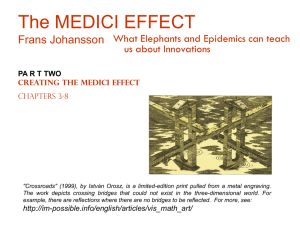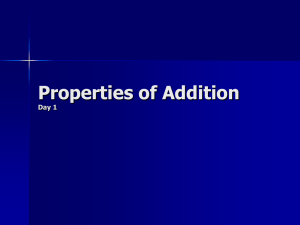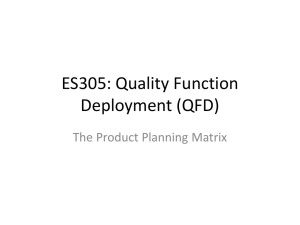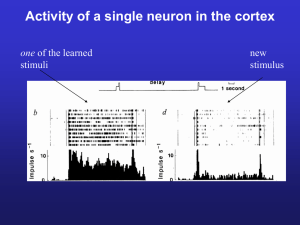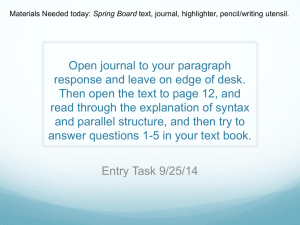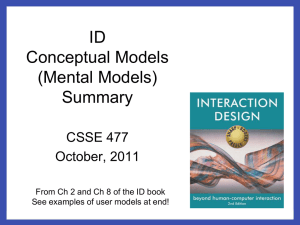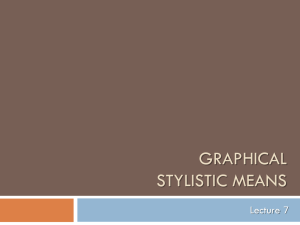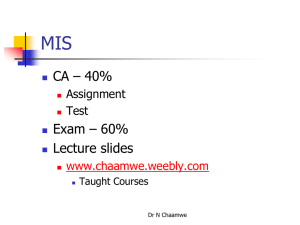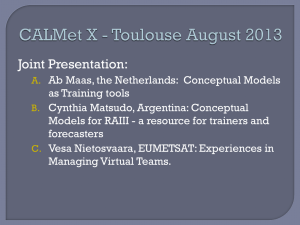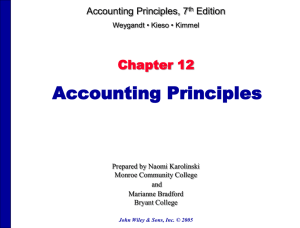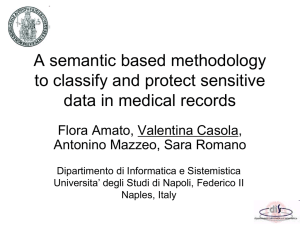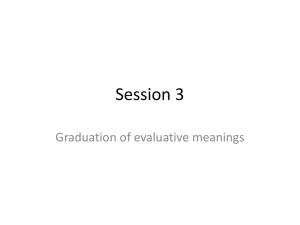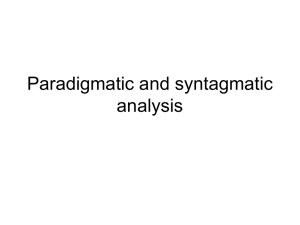5. 3. 2 Conceptual and associative meaning
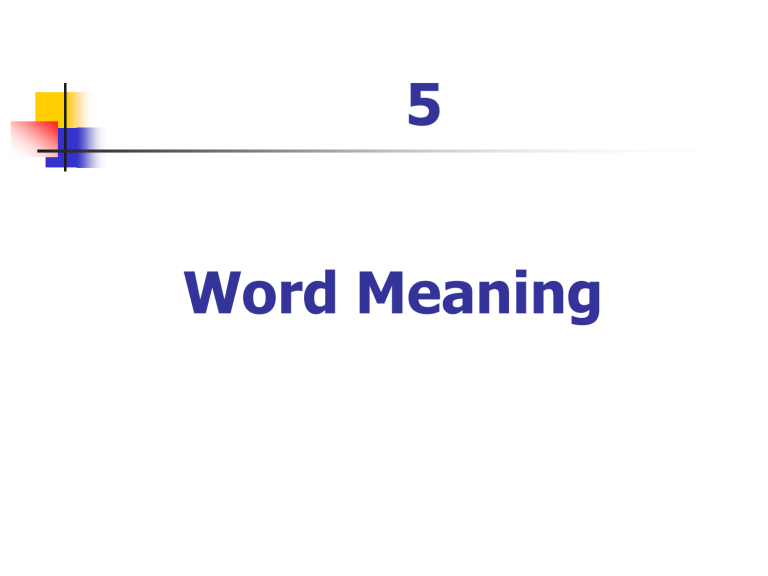
5
Word Meaning
Word Meaning
Two aspects of a word :
1. form—sound and spelling
2. content—meaning cat /k
æ t/ = a small four-legged animal with soft fur and sharp claws
Word-meaning is what the word denotes.
5.1 The Meanings of
‘meaning’
Meaning is reference.
5. 1. 1. Reference
the meaning triangle concept/idea referent train
/trein/ reference
5. 1. 1. Reference
Meaning is reference .
Reference is the connection between the word form and what the form refers to in the world .
Reference is the relationship between language and the world.
5.1.2 Concept
Meaning is concept.
5.1.2 Concept
Meaning and concept are closely connected but not identical .
Concept is beyond language .
It is the result of human cognition , reflecting the objective world in the human mind.
5. 1. 1. Concept
the meaning triangle concept/idea train
/trein/ reference referent
5.1.2 Concept
Concept is universal to all men alike regardless of culture, race, language and so on, whereas meaning belongs to language , so is restricted to language use.
5.1.2 Concept
妇女
Frau femme concept language
5.1.2 Concept
很多
(concept) much time much money much water many people many books many buildings
5. 1. 3. Sense
Meaning is sense.
5. 1. 3. Sense
Difference:
Reference is connected with language.
Concept is beyond language.
Sense is within the language .
5. 1. 3. Sense
Every word that has meaning has sense , but not reference .
probable, nearly, and, if, but, yes pavement—sidewalk pal—chum
5. 1. 3. Sense
So in most cases, when we talk about the meaning of a word, we actually mean sense .
5.2 Motivation
5.2 Motivation
Motivation accounts for the connection between the linguistic symbol and its meaning.
Since the relationship between the wordform and meaning is conventional and arbitrary , most words can be said to be non-motivated .
5.2 Motivation
But English does have words whose meanings can be reasonably explained to a certain extent .
There are mainly four types of motivation.
5. 2. 1. Onomatopoeic
Motivation
Words whose sounds suggest their meanings = onomatopeic words
Two types of words according to their sound similarity
5. 2. 1. Onomatopoeic
Motivation
1. Primary onomatopoeia bow wow ha ha ping-pong cuckoo miaow tick-tuck
5. 2. 1. Onomatopoeic
Motivation
2. Secondary onomatopoeia
cock —crow duck —quack frog —croak mice —squeak horse —neigh goat —bleat
5. 2. 2. Morphological
Motivation
Examples: airmail : mail by air reading-lamp : lamp for reading miniskirt : small skirt
The morphological structure suggests the meanings of the words .
5. 2. 2. Morphological
Motivation
BUT blackmail ≠ mail black in colour 讹诈
greenhand ≠ hand green in colour 新手
They are morphologically non-motivated .
5. 2.3. Semantic
Motivation
Examples : the tongue of the bell
the mouth of the river
The Yellow River is the cradle of
Chinese civilization.
These words are not used in their literal sense, but figurative meaning.
5. 2.3. Semantic
Motivation
We can understand them because there is a kind of resemblance between the two.
The figurative meaning is suggested by the literal meaning .
5. 2. 4. Etymological
Motivation
Examples : pen = feather → quill pen → any writing tool
笔 =bamboo + hair → modern writing tool quisling = Quisling → traitor braille = Braille → language for the blind
The meanings are related to their origins .
The meanings can be etymologically explained.
5.3 Types of Meaning
Word-meaning has different components.
These different components can be called different types of meaning.
5. 3.1. Grammatical and
Lexical Meaning
Grammatical meaning
Examples :
singular and plural meaning of nouns
countable and uncountable
tense meaning of verbs and their inflectional forms
transitive and intransitive
5. 3.1. Grammatical and
Lexical Meaning
Grammatical meaning show grammatical concepts or relationships .
What is left of the meaning of a word is the lexical meaning.
Lexical meaning is the basic meaning of the word, which is listed in the dictionary.
5. 3.1. Grammatical and
Lexical Meaning
Characteristics :
1. Different lexical items, which have different lexical meanings, may have the same grammatical meaning: table s , m e n, ox en , potato es
5. 3.1. Grammatical and
Lexical Meaning
2. The same word may have different grammatical meaning: for get , for gets , for got , for gotten , for getting
5. 3.1. Grammatical and
Lexical Meaning grammatical meaning word-meaning lexical meaning
5. 3.1. Grammatical and
Lexical Meaning conceptual meaning(CM) lexical meaning associative meaning(AM)
5. 3. 2 Conceptual and associative meaning
Conceptual meaning (denotative meaning) is the meaning given in the dictionary and forms the core of word-meaning.
Associative meaning is the secondary meaning supplemented to the conceptual meaning.
5. 3. 2 Conceptual and associative meaning
Compare :
CM fundamental universal stable
AM secondary contextual changing/ open-ended/ indeterminate
5. 3. 2 Conceptual and associative meaning
Associative meaning may change according to contextual factors such as: social background, role relationship, culture, age, sex, time , etc.)
5. 3. 2 Conceptual and associative meaning associative M connotative M (ConM) stylistic M (SM) affective M (AfM) collocative M (ConM)
5. 3. 2 Conceptual and associative meaning
1.
Connotative meaning
Definition :
Connotative meaning refers to the overtones or associations suggested by the conceptual meaning, traditionally known as connotations .
5. 3. 2 Conceptual and associative meaning
Example : dragon
Chinese power prosperity
good fortune royalty
Western violence monster killing
5. 3. 2 Conceptual and associative meaning
Be a man .
strength decisiveness wisdom courage etc.
5. 3. 2 Conceptual and associative meaning
2. Stylistic meaning
The stylistic meaning of a word is its stylistic feature: formal , informal , neutral .
Examples: room finish send try chamber complete dispatch endeavour
5. 3. 2 Conceptual and associative meaning
Martin Joos’ five scales: frozen formal consultative casual intimate
5. 3. 2 Conceptual and associative meaning charger steed horse nag plug
horse
frozen formal consultative casual intimate
5. 3. 2 Conceptual and associative meaning father, dad, daddy, pa, pappa, governor, male parent
5. 3. 2 Conceptual and associative meaning
3. Affective meaning
Affective meaning indicates the speaker’s attitude towards the person or thing in question. This meaning can be overtly and explicitly conveyed.
love, hate, anger, happy
5. 3. 2 Conceptual and associative meaning
appreciative pejorative famous determined slim/slender notorious pigheaded skinny/bony/skeletal
5. 3. 2 Conceptual and associative meaning
4. Collocative meaning
The part of the word-meaning is reflected in the collocation.
5. 3. 2 Conceptual and associative meaning
Examples : green on the job green fruit
(inexperienced)
(unripe) green with envy (envious) green -eyed monster (green colour)
5. 3. 2 Conceptual and associative meaning
1. Every dog has his day.
2. Let sleeping dogs lie.
3. Love me, love my dog .
person troubles friend
END
